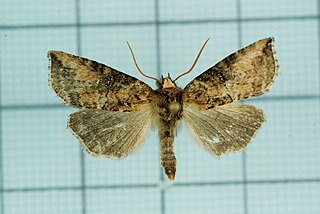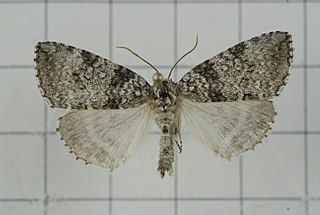
Drepaninae are by far the largest subfamily of the Drepanidae moths. While it is usually split into two tribes, Drepanini and Oretini, its internal systematics and phylogeny are not well resolved.

Achlya flavicornis, the yellow horned, is a moth of the family Drepanidae. The species was first described by Carl Linnaeus in his 1758 10th edition of Systema Naturae. It is found from Europe to the eastern Palearctic ecozone.
Oreta is a genus of moths belonging to the subfamily Drepaninae. The genus was erected by Francis Walker in 1855.

Epipsestis nikkoensis is a moth of the family Drepanidae first described by Matsumura in 1921. It is found in the Chinese provinces of Jilin, Shaanxi and Hubei and in Japan, Taiwan, the Russian Far East, Nepal, Bhutan, Myanmar, the Korean Peninsula, Thailand and northern Vietnam.

Oreta insignis is a species of moth of the family Drepanidae. It is found in Taiwan, China and Japan.

Oreta extensa is a species of moth of the family Drepanidae described by Francis Walker in 1855. It is found in China, Taiwan, India, Sri Lanka, Indonesia and Thailand.

Oreta fuscopurpurea is a species of moth of the family Drepanidae. It is found in Taiwan, China and Japan.

Macrothyatira flavida is a moth in the family Drepanidae first described by Arthur Gardiner Butler in 1885. It is found in the Russian Far East, Taiwan, Japan and China.

Tridrepana unispina is a moth in the family Drepanidae. It is found in China, Japan and Taiwan.

Tethea consimilis is a species of moth of the family Drepanidae first described by Warren in 1912. It is found in Asia, including the Russian Far East, Japan, Korea, Taiwan, Myanmar, Indonesia and India. The habitat consists of various types of mixed and broad-leaved forests.
Oreta eminens is a species of moth of the family Drepanidae first described by Felix Bryk in 1943. It is found in Myanmar, China, Korea and Japan.
Oreta pulchripes is a moth in the family Drepanidae. It was described by Arthur Gardiner Butler in 1877. It is found in China (Jilin), Japan, south-eastern Russia and Korea.

Oreta turpis is a moth in the family Drepanidae. It was described by Arthur Gardiner Butler in 1877. It is found in Japan, the Russian Far East, Korea and China (Shandong).
Oreta griseotincta is a moth in the family Drepanidae. It was described by George Hampson in 1893. It is found in China, Taiwan, north-eastern India, Sikkim, Malaysia and Singapore.
Oreta paki is a moth in the family Drepanidae. It was described by Hiroshi Inoue in 1964. It is found in Korea, China and the Russian Far East.
Oreta rubromarginata is a moth in the family Drepanidae. It was described by Charles Swinhoe in 1902. It is found on Borneo and Sumatra.
Habrosyne intermedia is a moth in the family Drepanidae. It is found in the Russian Far East, the Korean Peninsula, Japan, India, Nepal and China.
Tethea ampliata is a moth in the family Drepanidae. It is found in the Russian Far East, Korea, Japan, Taiwan and northern and north-eastern China.

Tethea octogesima is a moth in the family Drepanidae first described by Arthur Gardiner Butler in 1878. It is found in Japan, Korea, China, Taiwan and the Russian Far East.

Parapsestis argenteopicta is a moth in the family Drepanidae. It was described by Oberthür in 1879. It is found in the Russian Far East, Korea, Japan, Taiwan, western, north-eastern, northern and central China and Nepal. The habitat consists of various types of mixed forests and oak woods.












